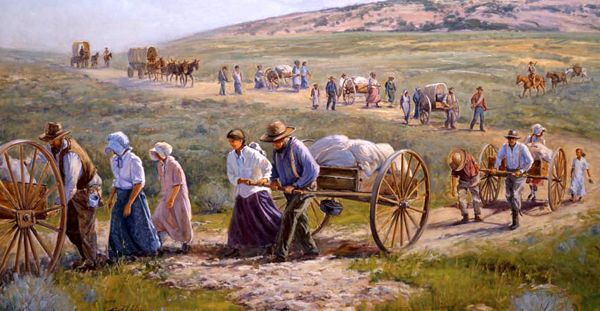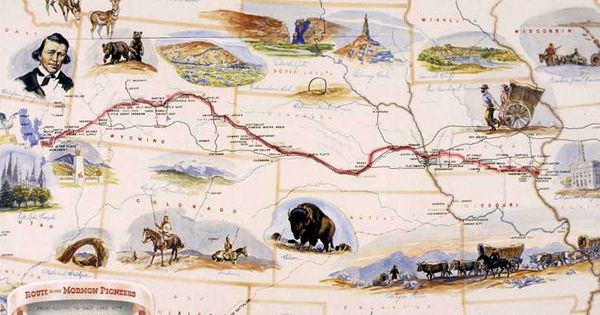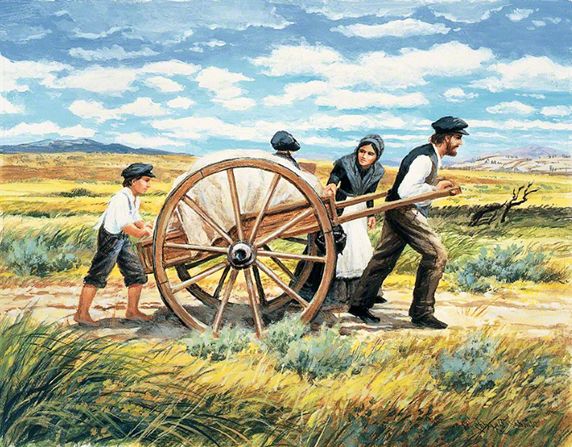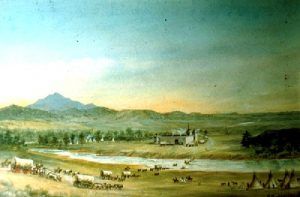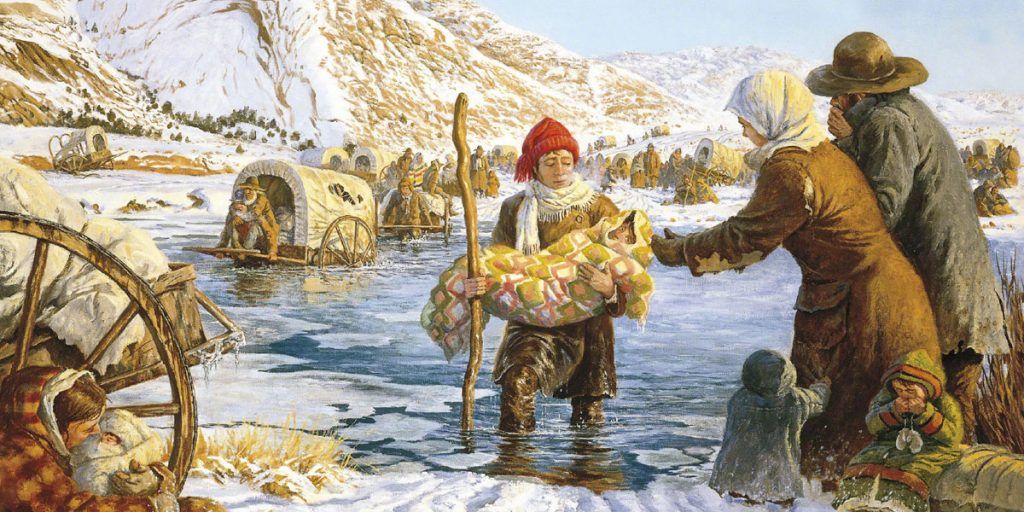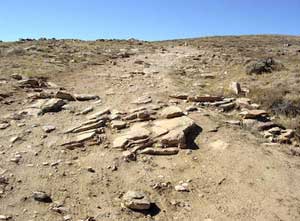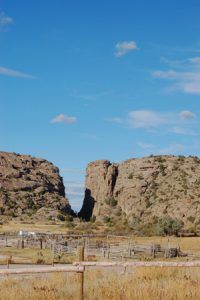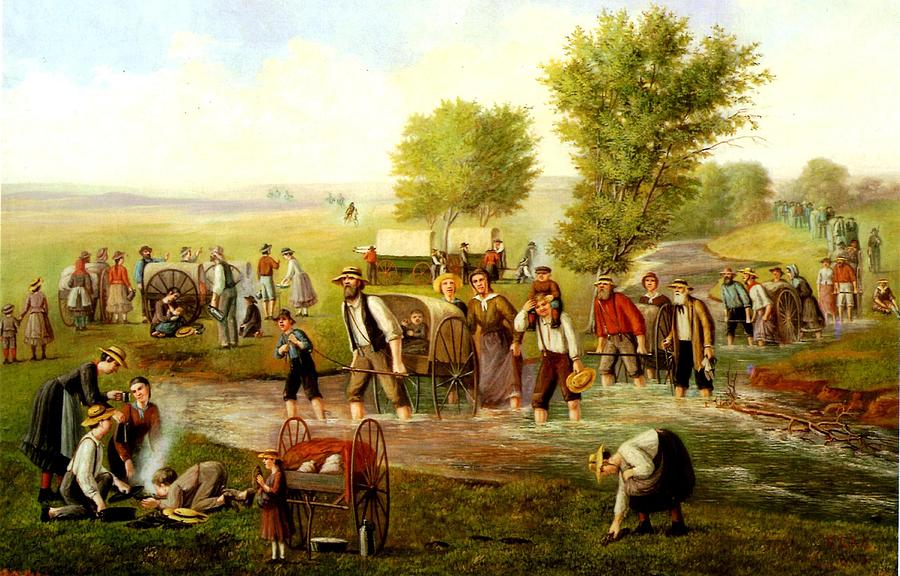“Let them come on foot with handcarts or wheelbarrows; let them gird up their loins and walk through, and nothing shall hinder or stay them.”
The Mormon handcart pioneers were participants in the migration of members of The Church of Jesus Christ of Latter-day Saints to Salt Lake City, Utah, who used two-wheeled handcarts to transport their belongings. The movement began in 1856 and continued until 1860.
In the 1850s, a series of poor harvests left the church with only a meager fund to help immigrants buy wagons and oxen, and church leaders looked for less expensive ways to move poor immigrants. As a result, Brigham Young announced on October 29, 1855, a handcart system by which the church would provide carts to be pulled by hand across the Mormon Trail. Young believed that with their carts and 90 days’ rations, the travelers could make the long journey to Utah Territory within 70 days, covering about 18 miles daily. This was less time than it took to travel in a covered wagon, which averaged about 73 days.
Ten handcart companies would make the trek during the four years the plan was in operation. These migrations included about 3,000 Mormon converts from England, Wales, Scotland, and Scandinavia in about 650 handcarts.
The carts were pulled from Iowa City, Iowa, a distance of 1,300 miles, or from Florence (Omaha), Nebraska which was 1,030 miles. Each cart carried 400 to 500 pounds of foodstuffs, bedding, clothing, and cooking utensils and needed two able-bodied people to pull it. Five people were assigned to each cart. Adults could take only 17 pounds of baggage, and children were allowed 10 pounds each. Families with small children traveled in covered or family carts with stronger iron axles.
Handcart company captains were men with leadership and trail experience. Each company included a few ox-drawn commissary and baggage wagons, at least one per twenty carts. Wagons or carts carried large public tents, one for every 20 people. Captains of 100 people had charge of five tent groups.
Tragedy
“Many a father pulled his cart, with his little children on it, until the day preceding his death.”
– John Chislett, a survivor
The trek was disastrous for two companies, which started their journey dangerously late and were caught by heavy snow and severe temperatures in central Wyoming. Despite a dramatic rescue effort, more than 210 of the 980 pioneers in these two companies would die along the way.
One of these companies, led by James G. Willie, left Iowa City on July 15 and crossed Iowa to Florence, Nebraska.
Before the Willie Company departed Nebraska, they met to debate the wisdom of such a late departure. But, because they were unfamiliar with the trail and the climate, they deferred to the church elders. One of the missionaries and sub-captain in the Willie Company, Levi Savage, urged them to spend the winter in Nebraska arguing that a late departure would lead to suffering, sickness and even death. However, all the other church elders argued that the trip should go forward, declaring that the company would be protected by divine intervention. As many as 100 pioneers decided to spend the winter in Nebraska or Iowa. However, most, including Levi Savage, continued the journey west. They left on August 17.
The last company, under Edward Martin, departed Florence on August 25. Two ox-wagon trains, led by captains W.B. Hodgett and John A. Hunt, followed the Martin Company.
In the fall, the Richards party, a group of fast-traveling missionaries returning to Utah from Europe, passed the Willie and Martin companies. On October 4, the Richards party reached Salt Lake City, conferring with President Brigham Young and other Church leaders, reporting that the two large handcart parties were still on the way.
The following day, the elders called on Church members to provide wagons, mules, supplies, and teamsters to find the latecomers and bring them in. On the morning of October 7, the first rescue party left Salt Lake City with 16 wagon loads of food and supplies, pulled by four-mule teams with 27 young men serving as teamsters and rescuers. Throughout October, more wagon trains were assembled, and 250 relief wagons were on the road by the end of the month.
In the meantime, the two companies of pioneers reached Fort Laramie, Wyoming, where they expected to be restocked with provisions. However, there were no provisions pre-stocked for them. As a result, the companies cut back on food rations, hoping that their supplies would last until help could be sent from Utah. Additionally, they lightened their loads, cutting individuals’ luggage allowance. Clothing and blankets that later would be desperately needed were discarded.
As the companies continued, they began running out of food and encountering bitterly cold temperatures. On October 19, a blizzard struck the region, halting the two companies and the relief party. The Willie Company was found along the Sweetwater River approaching the Continental Divide. A scouting party sent ahead by the main rescue party found the emigrants, gave them a small amount of flour, and encouraged them that rescue was near. The scouting party then rushed onward to try to locate the Martin Company.
At that time, the Martin Company was about 110 miles further east, making its last crossing of the North Platte River near present-day Caspar, Wyoming, where the trail left the river headed across the country toward Independence Rock and Devil’s Gate. Shortly after completing the crossing, the blizzard struck, and many company members suffered from hypothermia or frostbite after wading through the frigid river. The company set up camp at Red Bluffs, unable to continue through the snow.
One emigrant, Patience Loader, would later write:
“We had to travel in our wet clothes until we got to camp and our clothing was frozen on us and when we got to camp. . .it was too late to go for wood and water the wood was too far away that night the ground was frozen too hard we were unable to drive any tent pins in… we stretched it open the best we could and got under it until morning.”
Meanwhile, the members of the Willie Company quickly reached the end of their flour supplies and began slaughtering some cattle that remained. On October 20, Captain Willie and Joseph Elder traveled ahead of the pioneers by mule to locate the supply train and inform them of the company’s desperate situation. The pair arrived at the rescue party’s campsite near South Pass, Wyoming, that evening, and by the following evening, the rescue party reached the Willie Company and provided them with food and assistance. Leaving half of the rescue party to assist the Willie Company, the other half pressed forward to assist the Martin Company. Beyond the pass, the Willie company, now amply fed and free to climb aboard empty supply wagons as they became available, moved on quickly.
But the difficulties of the Willie Company were not yet over. Two days later, on October 23, the Willie Company faced the trail’s most challenging section — Rocky Ridge ascent. The climb took place during a howling snowstorm through knee-deep snow. That night 13 emigrants died.
Meanwhile, the Martin Company remained in the camp at Red Bluffs for nine days until three scouts finally arrived on October 28. By that time, 56 members of the company had died.
The scouts urged the emigrants to begin moving again. One of the first rescuers from Salt Lake City, Ephraim Hanks, soon arrived and provided buffalo meat to the starving party.
As the company moved from day to day, Hanks continued to kill many buffalo. He also performed many blessings and helped in some amputations to stop the progression of the frostbite and gangrene that would have otherwise killed more company members. Three days later, the main rescue party met the Martin Company and the Hodgett and Hunt wagon companies and helped them to Devil’s Gate, Wyoming.
At Devil’s Gate, the rescue party unloaded the baggage carried in the wagons of the Hodgett and Hunt wagon companies that had been following the Martin Company so the wagons could be used to transport the weakest emigrants.
The Martin Company continued, but severe weather forced them to halt at Martin’s Cove, where they stayed for five days. After they continued, a backup relief party of 77 teams and wagons went east to provide additional assistance. After passing Fort Bridger, the leaders of the backup party concluded that the Martin Company must have wintered east of the Rockies, so they turned back. When word of the returning backup relief party was communicated to Young, he ordered the courier to return and tell them to turn back east and continue until they found the handcart company, but several days had been lost.
In the meantime, the Willie Company arrived in Salt Lake City on November 9. Of the 404 still, with the company, 68 died, and many others suffered from severe frostbite and near starvation.
On November 18, the backup party met the Martin Company with the greatly needed supplies. The 104 wagons carrying the Martin Company arrived in Salt Lake City on November 30. At least 145 members of the company had lost their lives. Many of the survivors had to have fingers, toes, or limbs amputated due to severe frostbite.
After the companies arrived in Utah, the residents generously opened their homes to the arriving emigrants, feeding and caring for them over the winter. The emigrants would eventually go to Latter-day Saint settlements throughout Utah and the West.
Despite the tragedy, the Mormon church did not give up on the handcart plan. It sent a missionary company east with handcarts early in 1857 and sponsored five more westbound handcart companies by 1860. Once the church finances had recovered, Young’s followers returned to using conventional wagons.
Although fewer than ten percent of the 1846–68 Latter-day Saint emigrants made the journey west using handcarts, the handcart pioneers have become an important symbol in Mormon culture, representing the faithfulness and sacrifice of the pioneer generation.
© Kathy Alexander/Legends of America, updated March 2023.
Also See:
Brigham Young – Leading the Mormons
Sources:
Encyclopedia of Mormonism
History.net
Wikipedia
Wyoming History

